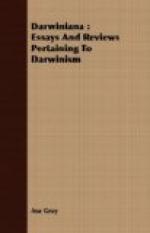Very similar would seem to have been the fate of a more familiar gymnospermous tree, the Gingko or Salisburia. It is now indigenous to Japan only. Its ancestor, as we may fairly call it—since, according to Heer, “it corresponds so entirely with the living species that it can scarcely be separated from it”—once inhabited Northern Europe and the whole arctic region round to Alaska, and had even a representative farther south, in our Rocky Mountain district. For some reason, this and Glyptostrobus survive only on the shores of Eastern Asia.
Libocedrus, on the other hand, appears to have cast in its lot with the Sequoias. Two species, according to Heer, were with them in Spitzbergen. L. decurrens, the incense cedar, is one of the noblest associates of the present redwoods. But all the rest are in the southern hemisphere, two at the southern extremity of the Andes, two in the South-Sea Islands. It is only by bold and far-reaching suppositions that they can be geographically associated.
The genealogy of the Torreyas is still wholly obscure; yet it is not unlikely that the yew-like trees, named Taxites, which flourished with the Sequoias in the tertiary arctic forests, are the remote ancestors of the three species of Torreya, now severally in Florida, in California, and in Japan.
As to the pines and firs, these were more numerously associated with the ancient Sequoias of the polar forests than with their present representatives, but in different species, apparently more like those of Eastern than of Western North America. They must have encircled the polar zone then, as they encircle the present temperate zone now.
I must refrain from all enumeration of the angiospermous or ordinary deciduous trees and shrubs, which are now known, by their fossil remains, to have flourished throughout the polar regions when Greenland better deserved its name and enjoyed the present climate of New England and New Jersey. Then Greenland and the rest of the north abounded with oaks, representing the several groups of species which now inhabit both our Eastern and Western forest districts; several poplars, one very like our balsam poplar or balm-of-Gilead tree; more beeches than there are now, a hornbeam, and a hop-hornbeam, some birches, a persimmon, and a planer-tree, near representatives of those of the Old World, at least of Asia, as well as of Atlantic North America, but all wanting in California; one Juglans like the walnut of the Old World, and another like our black walnut; two or three grapevines, one near our Southern fox grape or muscadine, another near our Northern frostgrape; a Tilia, very like our basswood of the Atlantic States only; a Liquidambar; a magnolia, which recalls our M. grandiflora; a Liriodendron, sole representative of our tulip-tree; and a sassafras, very like the living tree.




